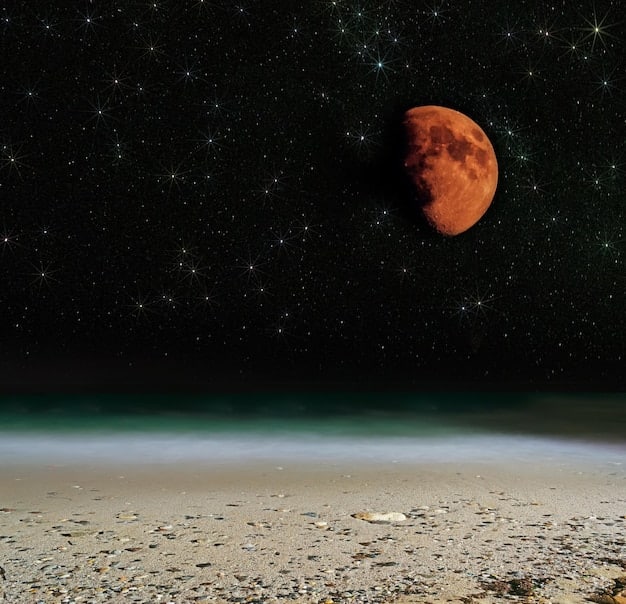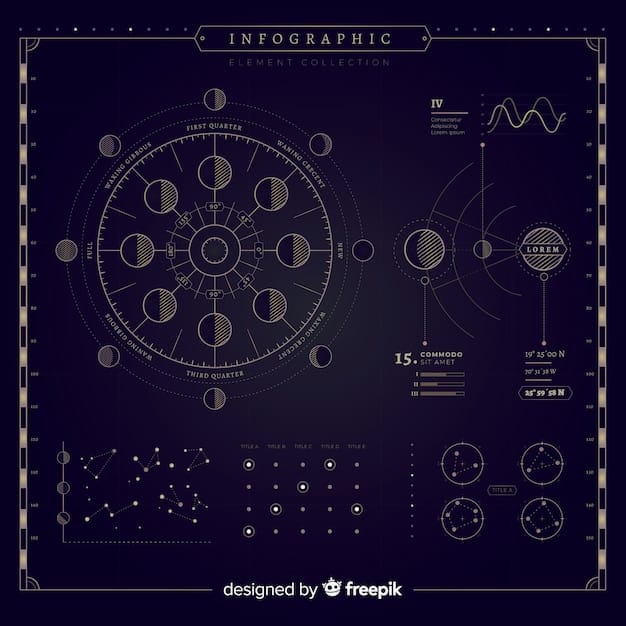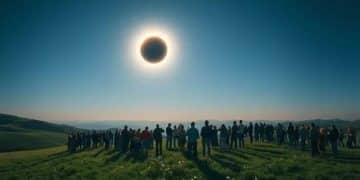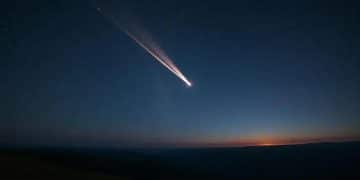Lunar Occultation of Mars: When to Watch in the US Sky

The lunar occultation of Mars, a rare event where the Moon passes in front of Mars, will be visible in parts of the US this year, offering a unique celestial viewing opportunity for sky enthusiasts.
Get ready for a celestial treat! This year, a rare event will grace the US skies: the **lunar occultation of Mars**. This is when the Moon passes in front of Mars, seemingly making the red planet disappear.
What is a Lunar Occultation of Mars?
A lunar occultation happens when the Moon moves between Earth and another celestial object, such as a star or a planet, effectively blocking our view of it. This event is similar to a solar eclipse, but instead of the Moon blocking the Sun, it obscures a more distant object in our solar system. For Mars, this means that for a brief period, the red planet will appear to vanish behind the Moon.
Lunar occultations of planets, especially bright ones like Mars, are relatively rare compared to occultations of stars. This is because planets move along the ecliptic—the path the Sun appears to take across the sky—which is also the Moon’s general path. However, precise alignments are needed for the Moon to pass directly in front of a planet, making these events special occasions for stargazers.

Why are Lunar Occultations of Mars Special?
Several factors contribute to the allure of lunar occultations of Mars:
- Rarity: These events don’t happen frequently, making each one a unique opportunity for observation. The exact timing and visibility depend on your location on Earth.
- Visual Spectacle: Watching a planet disappear and reappear behind the Moon is a captivating sight, even with the naked eye, though binoculars or a telescope enhance the view.
- Scientific Value: Although primarily enjoyed for their beauty, occultations can also be used for scientific measurements, such as refining our knowledge of the Moon’s orbit and the positions of stars and planets.
In summary, a lunar occultation of Mars is a noteworthy astronomical event due to its infrequency, the striking visual experience it offers, and its occasional scientific utility.
When and Where to See the Lunar Occultation of Mars in the US
Predicting the visibility of a lunar occultation involves complex calculations that depend on the observer’s location. Due to the Moon’s relatively close proximity to Earth, the exact timing and whether an occultation is visible can vary significantly across different geographic regions. This section will provide a general overview, but it’s essential to consult precise local predictions for your specific area.
While a specific date is required to give precise timing, it can be said the lunar occultations of Mars are more likely to occur when Mars is near opposition (when it’s closest to Earth and therefore brighter). Also, it is important to keep close tabs on reputable astronomy websites and apps that provide detailed information, including precise times, altitudes, and azimuths for when Mars will disappear and reappear behind the Moon as seen from your specific location.

Tips for Finding Accurate Local Predictions
To ensure you have the most accurate information, consider these resources:
- Astronomy Websites and Apps: Websites like TimeandDate.com or apps like SkySafari often provide detailed occultation predictions based on your GPS coordinates.
- Local Astronomy Clubs: Astronomy clubs frequently offer information about local events and may even organize viewing sessions.
- Planetarium Shows: Check with your local planetarium; they might have special presentations or resources about upcoming celestial events.
In conclusion, accurately determining the visibility of a lunar occultation of Mars requires location-specific data. Consulting reliable astronomy sources and apps is crucial for planning your observation.
Preparing to Observe the Lunar Occultation
Observing a lunar occultation of Mars can be a rewarding experience. However, a little preparation can greatly enhance your viewing session. This section outlines some essential tips to help you make the most of this celestial event.
First, find a location away from city lights to have a better chance to see the event; light pollution can significantly reduce the visibility of stars and planets. Next, check the weather forecast to make sure that skies will be clear on the night of the occultation. Finally, make sure to give your eyes time to adjust to the darkness (it can take up to 20 minutes).
Essential Equipment for Observing
While a lunar occultation of Mars can be observed with the naked eye, using optical aids can enhance the experience:
- Binoculars: A good pair of binoculars can provide a clearer view of Mars and the Moon, making the occultation more distinct.
- Telescope: For the best view, use a telescope. Even a small telescope will reveal details on the Moon’s surface and show Mars as a distinct reddish disk.
- Red Flashlight: Use a red flashlight to consult star charts or adjust equipment. Red light preserves your night vision better than white light.
In summary, the right location coupled with clear skies, and maybe some binoculars or a telescope, and you’ll be able to enjoy the lunar occultation. Observing a lunar occultation of Mars is simple, but the correct equipment can optimize the view.
Understanding the Science Behind Occultations
While lunar occultations of Mars are visually captivating events, they also have scientific significance. Careful observations can provide valuable data about the Moon, Mars, and even the Earth. This section delves into the scientific principles and applications of occultation observations.
One important aspect is the precise timing of the occultation which can help refine our understanding of the Moon’s orbit. Since the Moon’s position in the sky can be very accurately predicted, discrepancies between the predicted and observed times of an occultation can reveal subtle variations in the lunar orbit.
How Occultations Aid Scientific Research
Here are some key areas where occultation observations contribute to scientific understanding:
- Lunar Limb Profiles: Observing how a star or planet disappears behind the Moon can help map the Moon’s limb (edge) profile. This is especially useful for determining the heights of mountains and the depths of valleys on the lunar surface.
- Atmospheric Studies: In some cases, occultations can be used to study the atmospheres of planets, although this is more relevant for stars occulted by planets with substantial atmospheres.
- Refining Ephemerides: Occultation timings are used to refine the ephemerides (tables of predicted positions) of celestial objects, improving the accuracy of astronomical calculations.
In brief, lunar occultations are more than just pretty sights; they’re valuable tools for refining our understanding of the solar system. Occultation observations may not be as widely known as other astronomical studies, it’s worth noting the small part occultations play in our understanding of space.
The Cultural and Historical Significance
Throughout history, celestial events have held significant cultural and historical importance for societies around the world. Lunar occultations, while not as widely celebrated as eclipses or cometary appearances, have contributed to astronomical understanding and influenced cultural beliefs. This section explores some aspects of this influence.
In many ancient cultures, celestial events were interpreted as omens or signs from the gods. While there’s less direct evidence of specific myths or legends surrounding lunar occultations of Mars compared to solar eclipses, it’s reasonable to assume that these events were observed and interpreted within the existing cosmological frameworks.
Occultations in Ancient Astronomy
Here are a few ways occultations may have played a role in historical astronomical practices:
- Calendar Keeping: Precise observations of celestial events were crucial for developing accurate calendars. Occultations, along with other phenomena, would have helped refine astronomical models.
- Navigation: Celestial observations were essential for navigation. While occultations aren’t as straightforward to use for navigation as star positions, they contribute to the overall understanding of the night sky.
- Astrology: In cultures where astrology was prevalent, the positions of planets and their interactions were believed to influence human affairs. Occultations would have been incorporated into astrological interpretations.
To sum up, the significance behind lunar occultations throughout history is a sign that humans have been looking at the night sky for guidance for centuries. The integration of observations into calendar systems, navigation techniques, and astrology showcases the profound connection between celestial events and their earthly interpretation.
Future Lunar Occultations of Mars
While predicting the exact dates and visibility of future lunar occultations of Mars requires detailed astronomical calculations, we can discuss the general patterns and factors that influence their occurrence. This section provides an overview of what to expect in the coming years.
The frequency of lunar occultations of Mars depends on the relative positions of Earth, the Moon, and Mars as they orbit the Sun. Mars’s orbit is inclined to Earth’s orbit, meaning that Mars doesn’t always follow the same path as the Moon in the sky.
How to Stay Informed About Upcoming Events
Here are some ways to keep track of future lunar occultations of Mars:
- Astronomy Websites and Apps: Regularly check reputable astronomy websites and apps for updated event calendars and predictions.
- Astronomy Clubs: Join a local astronomy club to receive updates on upcoming events and participate in viewing sessions.
- Planetarium Shows: Attend planetarium shows to learn about celestial events and receive guidance on how to observe them.
Overall, the potential for future lunar occultations of Mars is dependent on variables, so staying informed through reliable astronomical sources is crucial for anyone eager to witness these celestial events.
| Key Aspect | Brief Description |
|---|---|
| 🔭 What is It? | The Moon passes in front of Mars, blocking it from view. |
| 🗓️ When to Watch | Check astronomy websites/apps for precise local predictions. |
| 📍 Where to See | Visible in parts of the US; location affects visibility. |
| 💡 Observing Tips | Use binoculars/telescope in a dark place; check the weather! |
Frequently Asked Questions
▼
A lunar occultation occurs when the Moon passes in front of a star or planet, effectively blocking it from view for a period of time. It’s similar to a solar eclipse, but with the Moon obscuring a more distant object.
▼
Lunar occultations of planets, including Mars, are relatively rare compared to occultations of stars. The frequency depends on the alignment of Earth, the Moon, and Mars in their orbits.
▼
Yes, you can often see a lunar occultation of Mars with the naked eye, especially if you are in a location with dark skies. However, binoculars or a telescope will enhance the viewing experience.
▼
You can find accurate predictions on reputable astronomy websites and apps like TimeandDate.com or SkySafari. These resources often provide detailed information based on your specific location.
▼
While it’s visible with the naked eye, binoculars or a telescope can enhance the view. A red flashlight is also useful for reading star charts without affecting your night vision. Ensure you find a viewing spot away from city lights.
Conclusion
The **lunar occultation of Mars** is a relatively rare event, a great treat for any stargazer. Remember to consult local astronomical resources for accurate timing, prepare your gear, and find a dark viewing location to get the best view of Mars disappearing behind the Moon.





